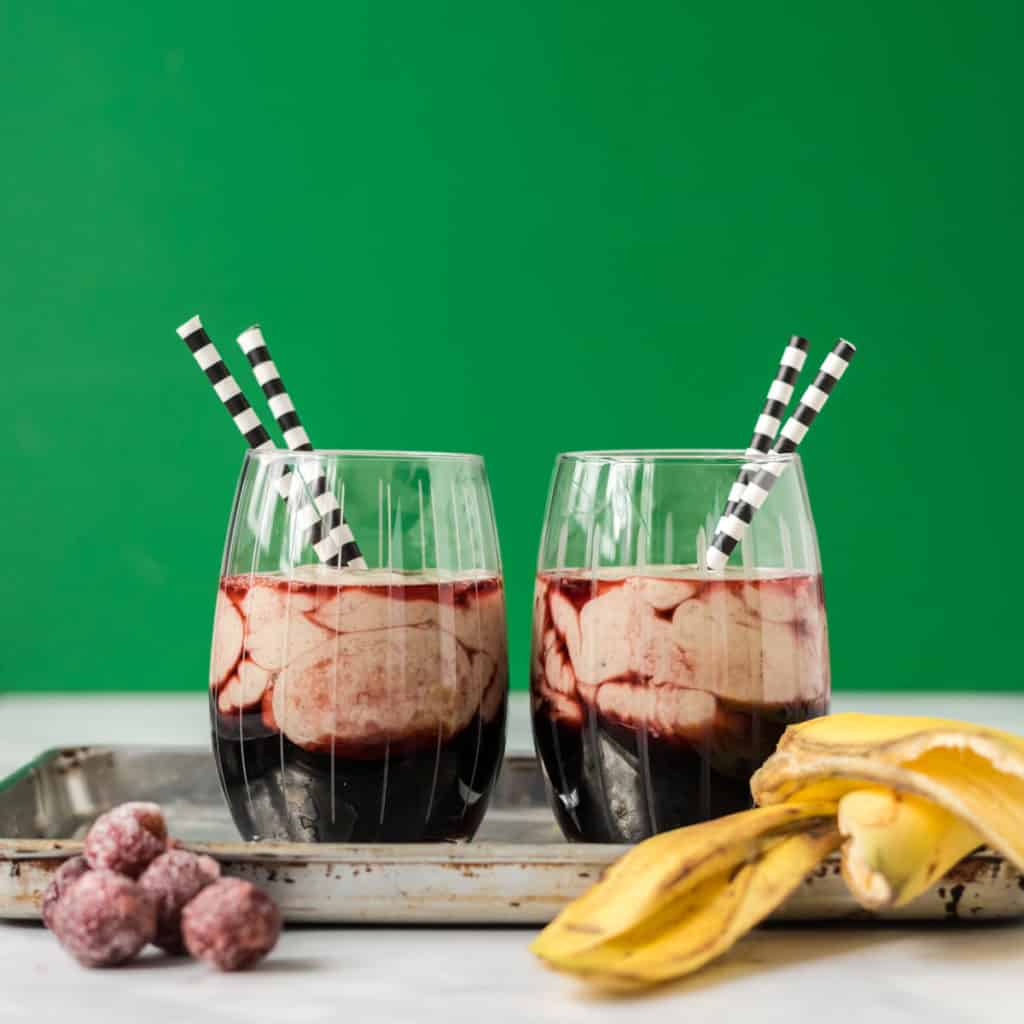The post was written as a paid collaboration with the Canadian Sugar Institute. As always, all opinions are our own.
“Juice is just liquid sugar! Sugar is toxic!”
“Cold-pressed juice will detoxify your body!”
If you find those two statements contradictory, you’d be correct. As Registered Dietitians, we find it rather humorous that there are two quite opposing camps of opinions when it comes to the same food!
And yes, the juice you find in the grocery store and the juice you find at the expensive cold-pressed juice bar are essentially the same thing once they hit your digestive system! It’s only the marketing that’s changed.
Side note: here’s a tip! If anyone uses the words ‘toxic’ or ‘detoxify,’ that’s a major red flag that what you’re about to read or hear is likely pseudo-science BS designed to instil fear in you! Run the other way as quickly as you can.
Table of Contents
Is Juice Less Healthy Than Eating the Whole Fruit? Does it Have More Sugar?
What exactly is juice? – it’s the liquid that’s been extracted from a fruit or vegetable, leaving behind all the solid material, which is essentially the fibre component. Fruits and vegetables that are used to make juice are typically low in fat & protein, high in water, sugar, vitamins & minerals, and contain a medium amount of dietary fibre. In the end, juice contains pretty much everything in the original fruit or vegetable except the fibre.
Initially, this sounds promising: not much nutrition is lost! Juice doesn’t have more sugar than the whole fruit!
However, that fibre plays a very important role.
- The fibre is what makes a fruit a solid instead of a liquid. A solid needs to be bitten and chewed before swallowing, which slows down the speed at which the food can be ingested. Contrast that to juice -a liquid-, which can quickly be swallowed without the need to spend anytime biting or chewing.
- The fibre provides your stomach with a feeling of fullness. It slows down digestion and helps you to regulate your intake to match your energy needs.
To illustrate the role of fibre, I got my husband to consume the same amount of calories in two different forms as quickly as he could: whole peeled oranges and as juice. It took him 3 minutes to eat the oranges while it only took him 30 seconds to drink the juice.
After eating 280 calories in the form of oranges…
- His stomach felt full
- He no longer had an appetite for oranges
- He couldn’t fathom eating any more oranges
But after drinking 280 calories in the form of juice…
- He didn’t feel full at all
- He was still enjoying the taste of the juice
- He could easily have continued drinking juice
The short answer is that juice doesn’t contain more sugar than whole fruit but it’s easier to consume a higher amount of sugar when it’s in liquid form than when you have to bite, chew, and swallow it.
Nutritional Value of Juice
As you can see, comparing whole fruit to juice using calorie matching is like comparing apples to oranges (joke intended, lol).
Let’s take a look at the two of them using commonly consumed serving sizes: one medium-sized (131g) orange and 1 cup (250 ml) of 100% orange juice.
| 1 medium sized (131g) orange | 1 cup (250 ml) of 100% orange juice | |
|---|---|---|
| Calories | 62 kcal | 129 kcal |
| Fibre | 2.3g | 0.8g |
| Sugar | 12.25g | 21.86g |
| Vitamin C | 69.7mg | 88.4mg |
| Potassium | 237mg | 468mg |
The juice essentially has double what the orange does, with the exception of the lost fibre and a bit of Vitamin C breaking down during processing.
Again: looking at the nutrition facts, they’re very similar. The difference is that it will take your child several minutes to eat the orange whereas the juice can be sucked back pretty quickly. It takes time during the eating process for our bodies to register the presence of food and compute the right amount of food to consume to match our energy needs. This is why slowing consumption down with chewing can be helpful in regulating intake appropriately.
Do Children Need Juice?
Kids need to eat a variety of foods in order to get a balanced diet that meets their nutritional requirements for growth and development.
Juice is a food that can be incorporated into a healthy, balanced diet but it’s not strictly necessary, nor is it strictly forbidden.
Since juice is a concentrated source of sugar without much fibre, fat, or protein, we’d caution against serving it to babies and children under the age of two on a regular basis.

Should You Decide to Offer Your Child Juice? How Much is Recommended?
In some cultures, juice is a cherished food.
Some kids may have a medical indication for which juice could be beneficial.
And some families simply enjoy drinking juice.
Remember that juice is a concentrated form of sugar that’s easy to consume quickly. We don’t want juice to take the place of other foods that children need to grow and develop.
For this reason, if you decide to serve juice to your child, we’d recommend keeping it to ½ cup (125 ml) a day. This is approximately what you’d get if you juiced one medium-sized piece of fruit.
When Can Juice be a Helpful Addition?
There are certain times when juice can be used as part of a nutrition strategy to meet certain needs!
Constipation: if your child struggles with constipation then juices that contain sorbitol, such as pear, prune, and apple juice could help to keep things moving along.
Urinary Tract Infections: if your child has difficulty with recurring urinary tract infections, drinking cranberry juice can help prevent the bacteria from adhering to the urinary tract.
Illness: if your child is sick and losing fluids from vomiting or diarrhea, drinking diluted juice can help replace lost fluids and electrolytes.
Meeting Vitamin C Needs: if your child is on a fruit and veggie strike, their body still needs Vitamin C! Offering juice can help the produce-adverse child meet their nutritional needs for this vitamin.

Should Juice be Diluted?
There are two differing viewpoints on whether to dilute juice for kids or not.
On the one hand, diluting juice with water brings down the bliss point and can stretch that ½ cup portion into a larger serving. This can be helpful to meet fluid needs for children who aren’t very interested in drinking plain water.
When I, Jessica, lived in Germany I noticed it was common for people to dilute juice with either water or sparkling water. When my German friend visited me in Canada, she commented that the juice was too sweet and asked for water to add to it.
Regularly consuming a food at a certain sweetness level can prime your palate and brain for how sweet it “should” taste to you. For this reason, parents may want to set their child’s expectation and preference up from a young age that diluted juice is the “norm” for them.
On the other hand, some people argue that diluting juice starts to blur the lines between juice and water so that kids might start to reject plain water and expect all their fluid intake to taste sweet.
We really don’t think there is one clear “right” or “wrong” when it comes to whether juice should be diluted for kids or not. It really depends on your family, your child, and what end goal you might be aiming for.
How to Shop for Juice
For many, shopping can be really overwhelming, especially when it comes to juice. You can find juice in the aisles of a grocery store, in the refrigerated area and also in the freezer aisle–there are so many options!
If you’re going for nutrition, our recommendation is to keep an eye out for juice that has no added sugar versus other options made from concentrate or powders with additional sugar. On the packaging, it will say “100% fruit juice”.
Beverages labelled as fruit punch, fruit drink, cocktail or fruit-flavoured beverages are likely to contain added sugar and very little else in the way of nutrients so it’s best to avoid these.
You may also find juices on the market that contain additional nutrients such as calcium or omega-3. If these are priority nutrients for you, feel free to purchase them!
What About Cold-Pressed and Homemade Juices?
If you’re reading this, there is a good chance you’ve been witness to the juice trend that made its way around the world around 2010! There’s nothing inherently wrong with cold pressed or homemade juices. However, it’s important to keep food safety top of mind. If you’re making homemade juice ensure you’ve thoroughly washed your produce, juicer and then store the juice appropriately.
The reason why this is important is because in Canada most of the juice you see has been pasteurised or heat-treated to kill potentially harmful bacteria. Essentially, it’s a public health protection measure! However, some juices on the market are not pasteurised so there is a small risk that bacteria can harbour in it. This is precisely why some of these juices are stored in the refrigerator.
Some families also enjoy juicing with their children as a means to encourage food exploration. Like all things in parenting, know the risks and take measures to ensure safety!

What are Other Ways to Utilise Juice?
Up until this point you might have visualized yourself or your child enjoying a glass of juice, but you can also use it as an ingredient! Juice lends itself beautifully along with other whole foods in:
- marinades
- smoothies
- pickling and
- baking recipes

How Can I Take a Body Positive and Food Neutral Stance on Juice?
Now that you’ve got a good understanding about juice–what it is, the recommendations and how to shop for it…how should you approach offering it to your children? Like with many things, the more you restrict juice intake the more likely it is that your child will become preoccupied by it.
Remember, children are biologically wired to enjoy sweet tastes. This happens at conception when they sip on sweet tasting amniotic fluid while in the womb and then both colostrum and human milk tend to be on the sweet side. All that to say, it’s normal for kids to have an affinity for juice.
Take a look at the table below where we offer you a different way to approach and talk about juice. Is there anything you’d add?
Food Parenting with Fear | Food Parenting with Trust |
|
|
If juice is something you want to serve from time to time, go ahead! When serving it, use neutral language and serve it along with other whole foods. Juice doesn’t need to be a moral dilemma–remember, no single food is inherently good or bad.
Food is food.
Juice is juice.






